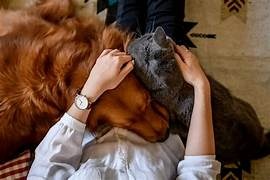
Fluff or Tough? The Ultimate Guide to High-Maintenance vs. Low-Maintenance Breeds
Discover the key differences, challenges, and rewards of caring for high-maintenance and low-maintenance dog and cat breeds to find the perfect furry companion for your lifestyle.
🐶 Pet Star
27 min read · 19, Jul 2025

Introduction: Why Breed Maintenance Matters
Choosing a pet is a deeply personal decision that requires thoughtful consideration beyond appearance or popularity. One of the most important factors to evaluate is the breed’s maintenance level—how much time, effort, and resources are needed to care for the animal properly.
High-maintenance breeds often require extensive grooming, specialized diets, and frequent veterinary care. On the other hand, low-maintenance breeds typically have minimal grooming needs and are generally easier to manage.
Understanding these distinctions can help prospective pet owners avoid surprises and build a fulfilling relationship with their pets. This article explores what defines high- and low-maintenance breeds, compares their characteristics, and provides expert insights to help you make an informed decision.
What Defines a High-Maintenance Breed?
Physical Grooming Needs
High-maintenance breeds often have long, thick, or curly coats that require regular brushing, trimming, or professional grooming. For example, Poodles and Afghan Hounds need constant coat care to prevent mats and tangles, while Persian cats require daily combing to avoid hairballs.
Health Considerations
Certain breeds are predisposed to genetic health issues that require extra medical attention, such as hip dysplasia in German Shepherds or respiratory problems in Bulldogs. These conditions can necessitate frequent vet visits, special diets, or medications.
Behavioral and Exercise Requirements
High-maintenance breeds often have specific exercise and mental stimulation needs. Border Collies, for example, require intense physical activity and cognitive challenges. Neglecting these needs can lead to destructive behaviors.
Characteristics of Low-Maintenance Breeds
Minimal Grooming
Breeds like the Beagle or the short-haired Domestic Shorthair cat have coats that require little maintenance, usually just occasional brushing and bathing.
Robust Health Profiles
Many low-maintenance breeds tend to be hardy with fewer genetic health problems, requiring only routine veterinary care.
Easygoing Temperaments
Low-maintenance breeds are often more adaptable and less demanding in terms of exercise and mental stimulation, making them suitable for busy owners or apartment living.
Comparing Grooming Requirements: Fluff or Tough?
Grooming Time and Costs
High-maintenance breeds can demand hours weekly for grooming or expensive salon visits. Low-maintenance breeds generally require minimal grooming tools and less frequent attention, saving time and money.
Impact on Owner Lifestyle
The grooming needs of a pet can significantly influence an owner’s daily routine. For example, busy professionals may find a low-maintenance breed easier to integrate into their lives.
Health and Veterinary Care: A Closer Look
Genetic Predispositions
High-maintenance breeds are often more prone to inherited diseases, leading to more frequent vet appointments and higher medical bills.
Preventive Care Strategies
Low-maintenance breeds often benefit from standard preventive care like vaccinations and parasite control, with fewer specialized interventions.
Behavioral Traits and Exercise Demands
Mental Stimulation Needs
Intelligent breeds like the Border Collie require regular mental challenges, while some low-maintenance breeds are content with basic obedience and play.
Exercise Requirements
High-energy breeds need daily vigorous exercise; low-energy breeds thrive with moderate or minimal activity.
Expert Opinions on Breed Maintenance
Veterinarian Insights
Veterinarians emphasize that breed maintenance should be matched with owner capacity to avoid stress and ensure pet welfare.
Professional Groomers’ Perspectives
Groomers often caution that neglecting grooming can lead to health issues in high-maintenance breeds.
Popular High-Maintenance Breeds: Profiles and Care Tips
Dogs
- Afghan Hound
- Poodle
- Shih Tzu
Cats
- Persian
- Maine Coon
- Sphynx
Popular Low-Maintenance Breeds: Profiles and Care Tips
Dogs
- Beagle
- Labrador Retriever
- Boxer
Cats
- Domestic Shorthair
- British Shorthair
- American Bobtail
How to Choose the Right Breed for Your Lifestyle
Assessing Your Time and Resources
Reflect on your daily schedule, budget, and living environment before choosing a breed.
Matching Personality and Activity Level
Select a breed whose temperament and exercise needs align with your lifestyle to ensure a harmonious relationship.
Training and Socialization: Maintenance Beyond Grooming
High-Maintenance Behavioral Training
Intelligent breeds often require advanced training and socialization to manage their energy and intellect.
Low-Maintenance Training Needs
Simpler training routines often suffice for low-maintenance breeds, though socialization remains critical.
Nutrition and Diet: Tailoring Maintenance Through Food
Dietary Needs of High-Maintenance Breeds
High-maintenance breeds often require specialized diets to support their health issues or activity levels. For example, large-breed dogs like German Shepherds benefit from joint-supporting nutrients such as glucosamine and chondroitin. Similarly, Persian cats may need diets that reduce hairball formation due to their dense fur.
In addition, high-maintenance breeds may be more sensitive to food allergies or intolerances, necessitating vet-guided dietary adjustments. Nutritional quality directly affects coat condition, energy levels, and overall wellbeing.
Feeding Low-Maintenance Breeds
Low-maintenance breeds generally thrive on balanced, commercial diets formulated for their size and activity level without requiring costly supplements. However, portion control and obesity prevention remain critical, especially since many low-maintenance breeds tend to be less active.
Behavioral Challenges: Managing High vs. Low Maintenance Breeds
High-Maintenance Breed Behavioral Traits
Certain breeds carry reputations for challenging behaviors that require time-intensive management. For instance, Siberian Huskies are notorious escape artists requiring secure fencing and mental engagement. Similarly, Toy breeds like Chihuahuas may develop “small dog syndrome” without proper training, becoming overly vocal or anxious.
Experts emphasize the importance of early socialization and consistent positive reinforcement training to address these behaviors. High-maintenance breeds benefit greatly from professional obedience classes and ongoing mental stimulation.
Low-Maintenance Breed Behavioral Profiles
Low-maintenance breeds typically have more predictable temperaments and fewer behavior issues. Labrador Retrievers, for example, are widely regarded as friendly and adaptable. Their manageable disposition often makes training straightforward, reducing stress for first-time pet owners.
Nonetheless, all breeds require basic behavioral training and socialization to ensure healthy interactions with people and other animals.
Grooming Tools and Techniques: Investing Wisely
Tools for High-Maintenance Breeds
Owners of high-maintenance breeds should invest in a comprehensive grooming toolkit including slicker brushes, combs, dematting tools, clippers, and grooming scissors. Regular grooming sessions prevent matting, skin infections, and discomfort.
Professional grooming appointments, often monthly, are typical for breeds like the Poodle or Maltese. Some owners opt for mobile grooming services to ease scheduling challenges.
Simpler Grooming for Low-Maintenance Breeds
For low-maintenance breeds, grooming routines are usually simpler, requiring occasional brushing and nail trimming. Basic supplies such as a bristle brush, nail clippers, and mild shampoo suffice.
Regular grooming not only maintains coat health but also facilitates early detection of skin issues or parasites, enhancing preventive care.
Case Studies: Real-Life Examples of Maintenance Levels
High-Maintenance Case: The Afghan Hound
Known for its luxurious, flowing coat, the Afghan Hound demands meticulous grooming. Owners report spending multiple hours weekly on brushing and detangling, plus frequent professional grooming. Their exercise needs are moderate but combined with grooming time, this breed suits experienced owners with time to dedicate.
Low-Maintenance Case: The Beagle
Beagles boast a short, weather-resistant coat requiring minimal brushing. They are generally healthy, with few genetic issues, and their friendly temperament and moderate exercise needs make them ideal for busy families or first-time dog owners.
Popular Myths About Breed Maintenance
Myth 1: High-Maintenance Means Difficult Temperament
Not always true. Many high-maintenance breeds, such as the Poodle, are known for intelligence and affectionate behavior, while some low-maintenance breeds can have stubborn or challenging temperaments.
Myth 2: Low-Maintenance Breeds Don’t Need Grooming
Even low-maintenance breeds require basic grooming to maintain skin health and hygiene. Neglect can lead to problems regardless of breed.
Myth 3: All Small Breeds Are High Maintenance
While many small breeds need grooming, some, like the French Bulldog, have relatively low maintenance needs compared to larger, fluffier breeds.
Conclusion
Choosing between a high-maintenance and a low-maintenance breed is a crucial decision that shapes the pet ownership experience. High-maintenance breeds often require substantial grooming, specialized health care, and ample mental and physical stimulation. These breeds are best suited for owners who have the time, resources, and dedication to meet their demanding needs. While these pets can offer extraordinary companionship, intelligence, and beauty, they also come with higher costs and responsibilities.
In contrast, low-maintenance breeds provide a more manageable alternative for individuals or families with busier lifestyles, limited space, or budget constraints. Their simpler grooming routines, generally robust health, and adaptable temperaments often make them ideal for first-time owners or those seeking a less intensive commitment. However, “low-maintenance” does not mean “no maintenance”—all pets require love, attention, training, and basic care to thrive.
The key to a rewarding pet-owner relationship lies in honest self-assessment of your lifestyle, resources, and expectations. By understanding breed-specific maintenance demands, you can choose a pet that fits well within your daily routine and long-term plans. This knowledge helps reduce the risk of surrender or neglect, leading to a happier, healthier life for both pet and owner.
Ultimately, whether you choose a fluffy, high-maintenance companion or a tough, low-maintenance friend, your commitment, care, and love are what matter most. Responsible pet ownership requires respect for the animal’s needs and a readiness to embrace the joys and challenges that come with it.
Frequently Asked Questions
Q1: What factors determine whether a breed is high or low maintenance?
A: Factors include grooming requirements, health predispositions, exercise needs, behavioral traits, and dietary demands.
Q2: Are high-maintenance breeds healthier or less healthy than low-maintenance ones?
A: High-maintenance breeds often have more genetic health issues, requiring frequent vet care, while low-maintenance breeds tend to be hardier.
Q3: Can a busy person successfully own a high-maintenance breed?
A: It’s challenging; high-maintenance breeds require significant time for grooming, exercise, and training.
Q4: How often should high-maintenance breeds be groomed?
A: Usually weekly brushing and monthly professional grooming are recommended, depending on the breed.
Q5: Do low-maintenance breeds require less training?
A: They generally need less intensive training but still require basic obedience and socialization.
Q6: Is cost significantly higher for high-maintenance breeds?
A: Yes, due to grooming, specialized diets, and veterinary care.
Q7: Are low-maintenance breeds better for apartment living?
A: Typically yes, as they adapt better to smaller spaces and have lower exercise needs.
Q8: Can grooming neglect cause health problems?
A: Absolutely, especially in high-maintenance breeds, leading to skin infections or discomfort.
Q9: What are good examples of high-maintenance dog breeds?
A: Afghan Hound, Poodle, Shih Tzu.
Q10: How can I prepare my home for a high-maintenance breed?
A: Invest in grooming tools, secure exercise space, schedule regular vet visits, and plan for training and enrichment activities.
Similar Articles
Find more relatable content in similar Articles

How Climate Change Affects Wild and Domestic Animals...
Climate change is dramatically.. Read More

Pets and Mental Health: The Science Behind Emotional H..
Discover the profound impact o.. Read More

The Growing Trend of Therapy and Emotional Support Ani..
Exploring the remarkable rise .. Read More

How Pets Strengthen Family Bonds...
Pets are more than just compan.. Read More
Explore Other Categories
© 2024 Copyrights by rPets. All Rights Reserved.